Abstract
A cascaded-like high-step-down converter (CHSDC) is proposed in this article, which can steeply convert a high voltage to a much lower level without the utilizing of extreme turns ratio or duty ratio. The proposed converter integrates two buck-boost converters and one forward converter to form a single-stage architecture containing only a single low-side driving switch, which, as a result, can lower the cost and reduce the complexity of the associated control driver. Even in a single-stage single-switch structure, the ability to step down input voltage is as effective as the cascade of two buck-boosts and one forward converter. Meanwhile, the proposed converter can avoid the low efficiency caused by a cascaded structure. Without an additional clamp circuit, the leakage energy stored in the transformer of the CHSDC can be still recycled so as to raise the efficiency of the converter and suppress voltage spikes at the power switch. Converter operation principle and key parameter design are discussed. Moreover, a 200 W prototype is built and then tested to validate the proposed converter and verify the theoretical analysis.
1. Introduction
Even though electric vehicles (EVs) have to be charged, the power for which comes from fossil-fuel plants, EVs can still reduce carbon dioxide production by 60% as compared with engine-system vehicles. EVs have been challenging the leading position of engine-system vehicles as a matter of course.
EVs commonly have two built-in DC voltage levels for different kinds of power supply, as shown in Figure 1. The purpose of the high-voltage battery bank is mainly to provide power for motor driving. Meanwhile, the low-voltage lithium-ion battery is for in-car auxiliary appliances such as the panelboard, dashcam, lighting, audio and video systems, air conditioner, automatic seat, and power steering wheel. The low-voltage lithium-ion battery has to be charged from the high-voltage bus. However, the low-voltage battery can alternatively be removed. With this approach, the auxiliary appliances will be powered by the high-voltage bus through a step-down converter with a high conversion ratio. No matter whether a low-voltage lithium-ion battery should be installed in EVs, a high step-down converter to steeply lower bus voltage for powering auxiliary appliances is certainly required.

Figure 1.
Structure of the power system of electric vehicles.
Conventional step-down converters, such as buck-derived DC/DC converters [1,2,3,4], can theoretically accomplish a high voltage-conversion ratio by operating under an extreme duty cycle. However, at the operating of an extreme duty cycle, significant conduction loss and switching loss, high voltage stresses, influential ripples, low efficiency of the converter, etc., will inevitably drop the performance of this kind of converter a lot. For efficiency improvement, among the buck-derived converters, some of them utilize soft-switching mechanisms into the converter design to increase efficiency. Nevertheless, an acceptable efficiency still cannot be obtained under an extreme duty ratio. As considering isolated topologies, the bridge-derived configurations can be a choice [5,6,7,8,9]. However, in order to obtain a huge conversion ratio, a higher turns ratio has to be adopted, which also decreases converter efficiency and then narrows the conversion range. Besides, multiple active switches will increase costs, the complexity of the drier, and the interference of switching noise.
The structure of a two-/multi-stage converter [10,11,12,13] can be an option for achieving an expected voltage gain and for a wide voltage-range operation. With the structure of multi-stages, the parameter tuning will have higher flexibility to average voltage stresses in each stage, which is one advantage of this kind of converter; however, it still has several drawbacks, such as at least two active switches need to be employed and it displays low overall efficiency. Therefore, a cascaded-like converter is developed, which possesses the characteristics of both a high voltage ratio and wide voltage range, the same as that completed by a two-stage converter, and only needs a single switch [14,15,16,17,18,19]. Nevertheless, their step-down voltage ratios still cannot be as high as for EV applications. Combining transformers into cascaded-like converters to further raise the voltage ratio is, therefore, studied [20,21,22,23,24,25], but high voltage spikes caused by the leakage inductance of a transformer need to be taken into consideration [21,22,23]. Usually, a snubber circuit or an active clamped cell is necessarily integrated into converter design [24,25], which accordingly increases cost and circuit complexity.
To step down a high voltage to a much lower level for auxiliary power applications in EV systems as well as overcome the aforementioned problems, a cascaded-like high-step-down converter (CHSDC) is proposed in this paper. As shown in Figure 2, the CHSDC integrates two buck-boost converters and one forward converter to be a single-switch single-stage architecture. It can accomplish a step-down voltage ratio as high as obtained by the three-stage cascade of two buck-boost converters and one forward converter. In addition, the CHSDC intrinsically has the features of leakage energy recycling and galvanic isolation.
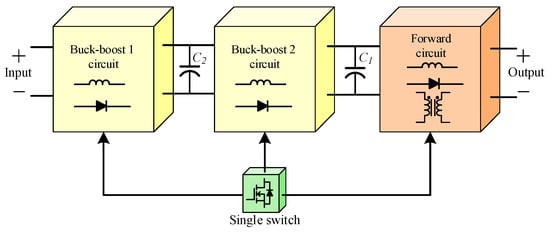
Figure 2.
A brief block diagram to illustrate the derivation of the proposed converter.
2. Converter Structure and Operation Principle
The main power circuit of the proposed CHSDC is depicted in Figure 3, which is derived from the integration of dual buck-boost converters and a forward converter to construct a single-stage structure with a single switch and galvanic isolation. Even though only one active switch is adopted, the CHSDC is able to step down input voltage as effectively as the cascade type of two buck-boost converters and one forward converter. The cascade of three converters needs three active switches at least, the worst of which belongs to a multi-stage structure, lowering overall efficiency dramatically. Therefore, the CHSDC is much better than the cascade structure.
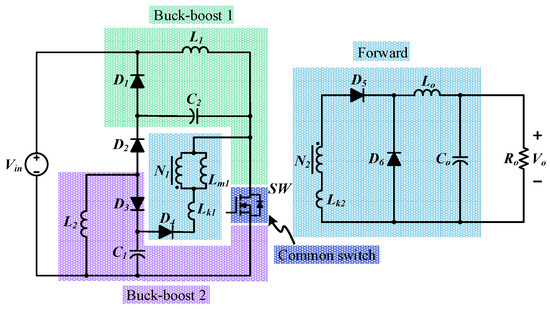
Figure 3.
The main power circuit of CHSDC.
As shown in Figure 3, it can be observed that the CHSDC incorporates buck-boost 1, buck-boost 2, and a forward, only using a common switch but still possessing a high conversion ratio achieved by a cascaded multi-stage converter. In the main power circuit, the equivalent of the high-frequency transformer includes a turns ratio of N2 to N1, a magnetizing inductance Lm1, two leakage inductances Lk1 and Lk2.
To clearly describe the operation of the CHSDC, the definitions of voltage polarity and current direction are shown in Figure 4. To simplify the analysis, the following assumptions are considered:
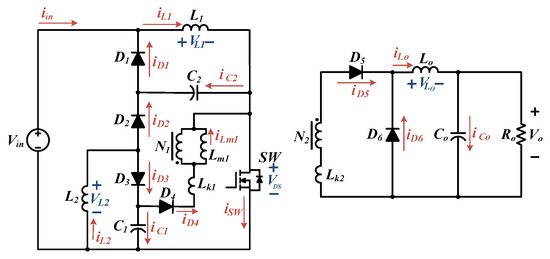
Figure 4.
Definitions of voltage polarity and current direction of the proposed converter.
- All the capacitors are large enough so that the voltages across them are regarded as constant and ripple-free;
- All semiconductor devices and diodes are ideal. That is, parasitic parameters can be neglected;
- The Lk1 and Lk2 represent the leakage inductances at the primary side and secondary side of the high-frequency transformer, respectively, values of which both are much smaller than the magnetizing inductance Lm1;
- The duty ratio of the switch SW will be less than 0.5;
- The turns ratio of the coupled inductor n is equal to ;
- The inductors L1 and L2 in the buck-boost circuits and the inductor Lo in the forward circuit all operate in continuous conduction mode (CCM).
The operation of the proposed CHSDC at steady-state and in CCM can be divided into five modes over one switching cycle. Figure 5 depicts the conceptual key waveforms of this converter, while Figure 6, Figure 7, Figure 8, Figure 9 and Figure 10 are the equivalents for each mode in turn. In the following, the five operating modes of the converter will be discussed mode by mode.

Figure 5.
Conceptual key waveforms of the converter in the CCM situation.
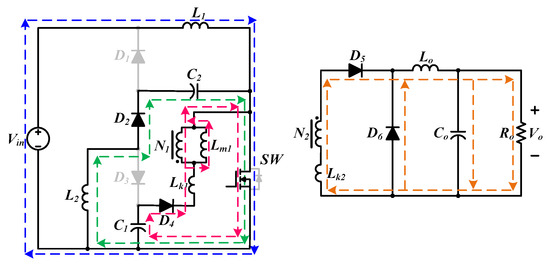
Figure 6.
Equivalent circuit of the CHSDC in Mode 1.
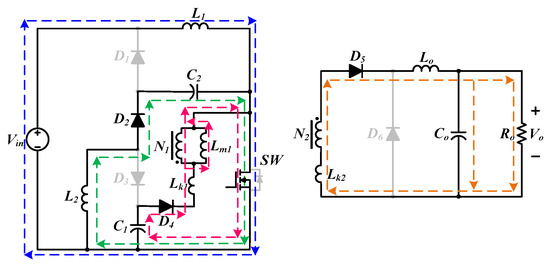
Figure 7.
Equivalent circuit of the CHSDC in Mode 2.
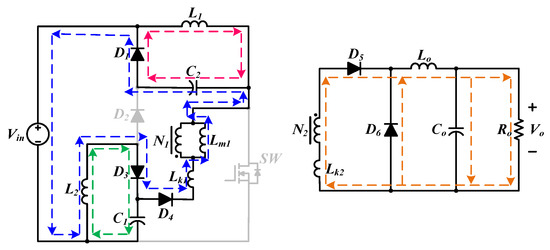
Figure 8.
Equivalent circuit of the CHSDC in Mode 3.
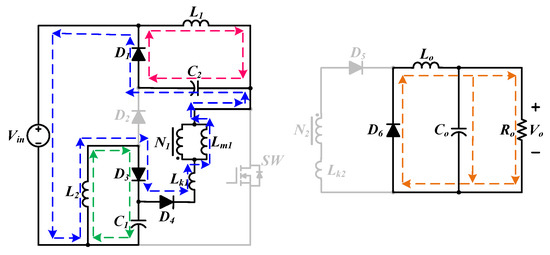
Figure 9.
Equivalent circuit of the CHSDC in Mode 4.
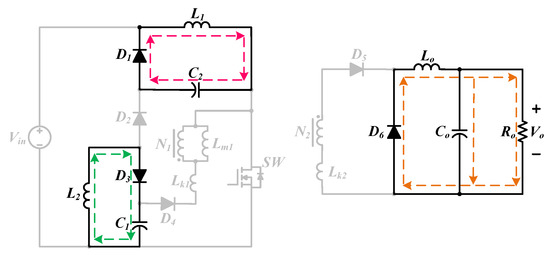
Figure 10.
Equivalent circuit of the CHSDC in Mode 5.
- Mode 1 [t0~t1]:
As shown in Figure 6, Mode 1 begins when the power switch SW is turned on at t0. During the time interval of Mode 1, diodes D2, D4, D5, and D6 are in forwarding bias, but diodes D1 and D3 are reversely biased. During this short-time transition, the current of the leakage inductor Lk1, iLk1 increases linearly. Meanwhile, the current flowing through Lk2, iLk2 also increases linearly. The energy of inductor Lo is delivered to the load and capacitor Co. As the increasing current of iLk2 is equal to the current of iLo, the diode D6 becomes OFF and this mode ends.
- Mode 2 [t1~t2]:
Mode 2 lasts from t1~t2. The equivalent circuit of Mode 2 is presented in Figure 7, which indicates that the SW, D2, D4, and D5 are still conducting and diodes D1, D3, and D6 are OFF. Inductor L1 absorbs energy from the input voltage, and capacitor C2 charges the inductor L2 through switch SW and diode D2. In addition, capacitor C1 forwards its stored energy to the low-voltage side through the high-frequency transformer to supply the output. Thus, the leakage–inductance current iLk1 and magnetizing–inductance current iLm1 are increasing linearly, as does the output–inductor current iLo. As the switch SW is turned off, the operation of the converter enters the next mode.
- Mode 3 [t2~t3]:
Mode 3 starts at time t = t2. Figure 8 is the related equivalent, where switch SW and diode D2 are in OFF state but diodes D1, D3, D4, D5, and D6 are in ON-state. During this short period, the energy stored in Lk1 is recycled to capacitor C2 and the input voltage through diode D1. At the same time, the leakage energy of Lk2 is recycled to the capacitor Co via the diode D5. In this mode, capacitor C2 is also charged by the inductor L1, and capacitor C1 is charged by L2 via diode D3. This mode ends when leakage energy in Lk2 releases completely at t = t3.
- Mode 4 [t3~t4]:
After leakage inductance releases all stored energy, diode D5 becomes OFF and converter operation will be in Mode 4. As illustrated in Figure 9, the switch SW remains OFF and diodes D2 and D5 are reversely biased. On the contrary, diodes D1, D3, D4, and D6 are forwarded. Leakage inductance Lk2 keeps recycling its energy. In this time interval, the currents iLk1 and iLm1 decrease linearly. On the low-voltage side, output inductor Lo still supplies for the output as well as capacitor Co. When the leakage-inductance current iLk1 and magnetizing-inductance current iLm1 drop to zero at t = t4, the next operation mode begins.
- Mode 5 [t4~t5]:
As indicated in Figure 10, this equivalent circuit is for Mode 5, the switch SW is still in OFF-state, diodes D1, D3, and D6 are in forwarding bias, and diodes D2, D4, and D5 are reverse biased. In this mode, capacitor C2 is charged by inductor L1 through diode D1, while inductor L2 charges capacitor C1 via diode D3. The output inductor Lo keeps energy-supplying for the load. This mode ends when switch SW is turned on. The complete operation of the converter finishes at t = t5.
3. Steady-State Analysis
3.1. Voltage Gain
The followings discuss the voltage gain derivation of the converter. The definitions of voltage polarity and the current direction are according to Figure 4. Applying the voltage-second balance principle to output inductor Lo yields
in which the VLo,on and VLo,off are denoted as the voltages across the inductor Lo during the intervals of SW ON and OFF, respectively, D stands for the duty ratio of the active switch, and Ts is switching period. As indicated in Figure 7, while SW is in ON state, the voltage of inductor L1, VL1,on, and the voltage of inductor L2, VL2,on, can therefore be found as follows:
and
Additionally, as the switch is ON, the voltage across inductor Lo, VLo,on, is expressed as
When switch SW is OFF, as depicted in Figure 10, the voltages across inductors L1, L2, and Lo are
and
respectively. By substituting (4) and (7) into (1), the output voltage Vo is obtained as
While applying the criterion of voltage-second balance to the inductors L1 and L2 individually, the capacitor voltages VC1 and VC2 in terms of duty ratio D and input voltage Vin can be given as
and
respectively. Then, substituting (8) into (9), as a result, the converter voltage ratio of output to input is estimated as
While the CHSDC is in CCM operation, the relationship of voltage gain versus switch duty cycle D, under different turns ratios of the transformer, is illustrated in Figure 11. It can be observed that the CHSDC is capable of stepping down a high input voltage significantly even under the operating with a regular turns ratio. That is, this converter can avoid employing a high turn-ratio transform. As revealed in Figure 11, the CHSDC achieves a conversion ratio of 0.03 at the conditions that turn ratio is 1:3 and duty cycle is 0.34. That is, based on this conversion ratio, the CHSDC can deal with a 400 V input voltage to power a 12 V load.
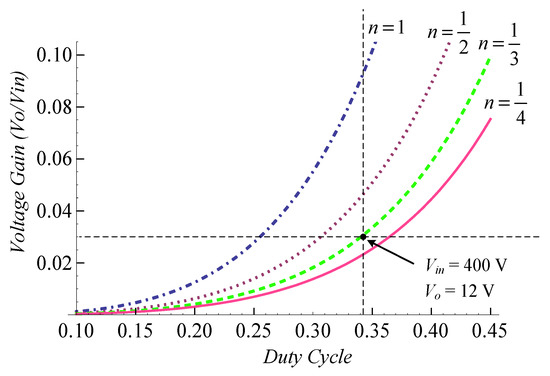
Figure 11.
Relationship among voltage gain, duty ratio, and turns ratio.
3.2. Voltage Stresses of Semiconductors
In order to choose a proper power switch and diodes, the determination of voltage stress and current stress for each semiconductor device has to be fulfilled. According to Figure 10, during the period of SW OFF, the blocking voltages of the SW and diodes D2, D4, D5 can be expressed as
and
in turn. Similarly, according to Figure 7, during the period of SW ON, the blocking voltages of diodes D1, D3, and D6 are, respectively, denoted as follows:
and
3.3. Current Stresses of Semiconductors
Since the output inductor Lo is in series with the output port, the inductor current iLo will be equal to the output current io and can be calculated by
In (19), R is the load resistance. As referred to Mode 2 and Mode 5, the inductor current iLo passes through diode D5 and diode D6 when SW is ON and OFF, respectively. Therefore, the current stresses of D5 and D6 will be identical to each other, which are obtained as
For determining the current stresses of the other semiconductor devices, including D1, D2, D3, D4, and SW, average currents of Lm1, L1, and L2 along with the capacitor current of C1 during SW-ON, that is, iLm1,avg iL1,avg, iL2,avg, and iC1,on, have to be found in advance. To comprehend the finding, the waveform of iLm1 is depicted in Figure 12, based on which the current iLm1,avg can be computed as
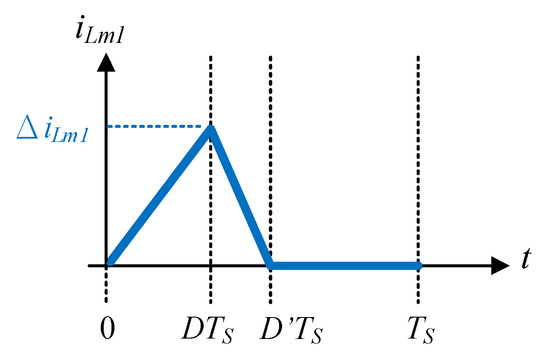
Figure 12.
The waveform of magnetizing–inductance current iLm1.
The ΔiLm1 in (21) is equal to
Placing ΔiLm1 in (22) into (21) yields
Based on Mode 2 and Mode 5, the expresses of iL1,avg, iL2,avg, and iC1,on can be figured out as follows:
and
Suppose that the input power will equal output power. That is,
Since the voltage gain of the CHSDC has been obtained in (11), the input current of the converter can be
Substituting both relationships of (19) and (28) into (24), (25), and (26), individually, the currents of iL1,avg, iL2,avg iC1,on are therefore obtained as
and
Because the average current flowing through diode D1 and the inductance current iL1,avg are the same, the following relationship holds:
Besides, the average currents of D2 and D3 are equal to the inductor current iL2,avg, which leads to
Concerning the current stress of D4, it can be determined as
For active switch SW, Mode 2 is referred and then, its current stress is denoted as
Substituting (29), (30), and (31) into (35), the current stress of SW, iSW,avg, is then obtained as:
3.4. Inductance Design
To guarantee that the converter operation is in CCM, all the minimum currents of the inductors Lo, L1, and L2, that is, iLo(min), iL1(min), and iL2(min), are set to be zero and accordingly the following relationships hold:
and
Based on (37)–(39), the required minimum inductances of Lo, L1, and L2, denotes as Lo(min), L1(min), and L2(min), respectively, to ensure the CHSDC is in CCM are determined as
and
3.5. Capacitance Design
In the CHSDC, the larger the capacitances are, the smaller the voltage ripples become. In order to suppress voltage ripples within the requirements, estimating for the minimum capacitances should be fulfilled. Voltage variation on a capacitor is given as
with (43), the capacitances of C1, C2, and Co can be derived as:
and
The equivalent series resistance (ESR) in a capacitor will dissipate power and thus lower converter efficiency. It seems that a much higher capacitance should be designed, however, which raises the cost. Therefore, an appropriate capacitance should compromise with voltage ripples. When building the CHSDC prototype, we consider to the voltage ripples of the capacitors C1, C2, and Co should be under 1 V, 5 V and 0.1 V, when the capacitance of each capacitors are 47 μF, 4.7 μF and 470 μF.
3.6. Performance Comparison
Table 1 summarizes the comparison of the proposed converter with other step-down converters. The performance comparison includes voltage gain, the numbers of semiconductor devices, the numbers of capacitors and magnetic elements, isolation features, and the ability of leakage-energy recycling. Table 1 reveals that the merits of the proposed converter contains: having the mechanism of leakage-energy recycling, a lower number of switches, lower capacitance used, and a better voltage gain. As illustrated in Table 1, even though the proposed CHSDC only requires a single power switch, it can still achieve an excellent step-down competence over all possible range of duty ratios, almost surpassing other similar converters. In addition, the CHSDC has the mechanism of leakage-energy recycling and the feature of galvanic isolation. There are six diodes in the proposed converter, which would imply that, because more diodes are utilized, conversion efficiency would be dropped dramatically. However, among all diodes in the CHSDC, two diodes are located on the low-voltage side. The low-voltage diodes can avoid the converter from consuming too much power. Concerning the number of magnetic elements, since the proposed converter is mainly derived from the integration of two buck-boosts and one forward converter, theoretically, the converter will contain more magnetic components. Nevertheless, from the viewpoint of gaining a higher voltage ratio, it is worthwhile. The designs of the magnetic components are in DCM while operating below two-thirds of the load, which means that lower inductances can be considered. Conduction loss can be accordingly restrained. In addition, leakage energy stored in the transformer of the CHSDC can be recycled. Owing to the inductor design and energy-recycling competence, even though more magnetic components are used, power loss still can be suppressed.

Table 1.
Performance comparison among the proposed converter and other recently proposed topologies.
4. Experimental Results
To prove the theoretical derivation, illustrate the performance, and verify the validity of the CHSDC, a 200 W prototype is constructed and then tested. The input voltage of the converter is 400 V and the output voltage is 12 V. The key parameters of the prototype are summarized in Table 2. Figure 13a shows the waveforms of the practical input current and the related control signal, while Figure 13b is the corresponding simulations. Figure 13 reveals that the practical measurements can be consistent with the simulations. In addition, Figure 13 also illustrates that energy stored in leakage inductance can be recycled to the input source and the converter can avoid extreme duty-cycle operation even under the full-load condition. The duty ratio of the switch is close to 0.34, instead of operating in a heavy-duty ratio. Figure 14 is the voltage and current waveforms of the active switch with practical measure and simulation. It reveals that the average current of the switch is about 9.5 A, which is close to the calculation result of 9.91 A with (36). The current stresses of D1–D6 are calculated with (20) and (32)–(34), individually, then to be 1.48 A, 2.87 A, 2.87 A, 5.5 A, 16.6 A, and 16.6 A, respectively, all of which match with the measurement results of iD1 to iD6 in Figure 15. In addition, Figure 15a,g demonstrates that diodes D1 and D4 both have the feature of zero-current switching (ZCS) during the turn OFF transition. Experimental and simulated current and voltage waveforms of inductors and the output capacitor are also presented in Figure 16 and Figure 17, respectively. Figure 16b shows the simulated inductor currents iL1 and iL2, while Figure 16a is their practical measurements. From Figure 16, it can be observed that the inductors L1 and L2 are in DCM and CCM, respectively, which have confirmed the theoretical derivation in Section 3.4. Figure 17b is the simulated output voltage vo and output inductor iLo, practical measurements of which are demonstrated in Figure 17a. As shown in Figure 17, it can be found that the output inductor Lo is in CCM, and the output voltage is controlled at a stable level of 12 V with a quite small ripple of less than 1%.

Table 2.
Parameters and components used in the prototype.
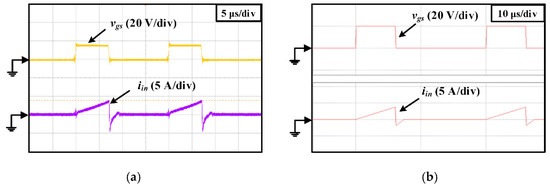
Figure 13.
The waveforms of the control signal and the corresponding input current: (a) measured waveform, (b) simulated results.

Figure 14.
The waveforms: (a) measured switch voltage and current, (b) simulated control signal and switch current.
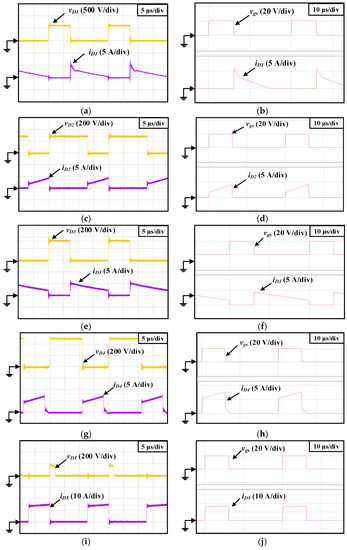

Figure 15.
Measured results and simulations of all diodes in the proposed converter: (a) practical measurements of diode D1, (b) simulated results of diode D1, (c) practical measurements of diode D2, (d) simulated results of diode D2, (e) practical measurements of diode D3, (f) simulated results of diode D3, (g) practical measurements of diode D4, (h) simulated results of diode D4, (i) practical measurements of diode D5, (j) simulated results of diode D5, (k) practical measurements of diode D6, and (l) simulated results of diode D6.

Figure 16.
The waveforms of iL1 and iL2: (a) practical measurements, and (b) simulated results.
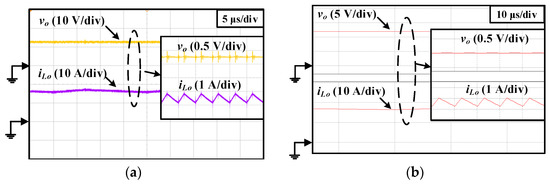
Figure 17.
The waveforms of vo and iLo with zoomed-in observation: (a) practical measurements, and (b) simulated results.
Figure 18 gives the voltage gain of the proposed converter in comparison with the step-down converters in [3,10,14,25]. It shows that the proposed converter is better at stepping down a high input voltage than other similar converters. Figure 19 expresses the power budget of the proposed CHSDC while operating in the full-load situation, in which diode loss accounts for 56% of the total loss. Switch loss accounts for 11%, while inductor loss, transformer loss, and capacitor loss are 15%, 11%, and 7%, respectively. The efficiency of the CHSDC is measured per 20 W from light load to full load. Figure 20 depicts the measured results. From this figure, the highest efficiency is around 93% at 140 W and 91% at the full load. Figure 21 is the photograph of the prototype of CHSDC.
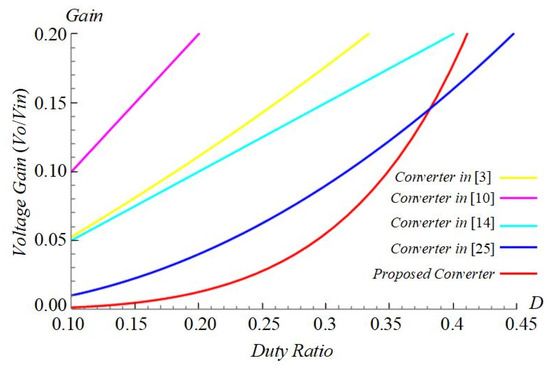
Figure 18.
Voltage-gain comparison with other similar converters in [3,10,14,25].
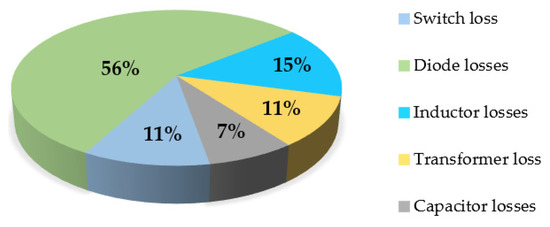
Figure 19.
Power budget of the CHSDC.
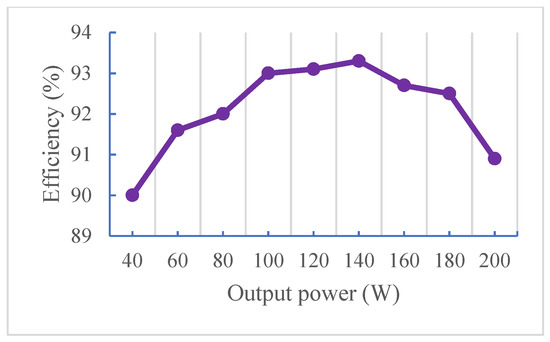
Figure 20.
Measured efficiency of the CHSDC from light load to full load.
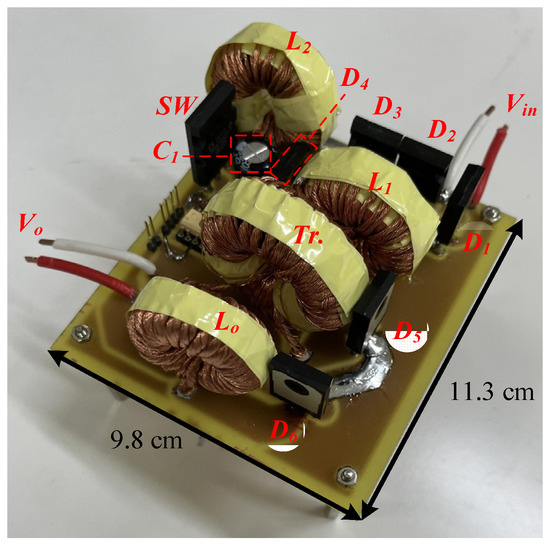
Figure 21.
The photograph of the CHSDC.
5. Conclusions
In this article, a high step-down converter is proposed, which is able to accomplish an excellent voltage conversion ratio, avoiding the adopting of high turns ratio and extreme switch cycle. That is, the proposed converter can step down a high input voltage to a much lower level under a regular switch cycle and turns ratio. In the power stage, the CHSDC integrates two buck-boost circuits and one forward circuit to be a single-stage single-switch structure to achieve an excellent voltage conversion ratio which is the same as the effect obtained by the cascade of the three converters. Because only one switch is needed, the complexity of driving circuit design is reduced significantly. The leakage energy stored in the transformer can be recycled for improving the conversion efficiency of the converter and suppressing voltage spikes on the power switch as well. Furthermore, diodes D1 and D4 possess ZCS-off features. The operation principle, steady-state analysis, and parameter design of the converter in CCM have been explored. Finally, the correctness of the theoretical analysis and the feasibility of the converter are verified through the measurements from a 200 W prototype.
Author Contributions
Conceptualization, C.-L.S. and L.-Z.C.; methodology, T.-Y.C.; validation, Y.-S.L. and L.-Z.C.; formal analysis, L.-Z.C. and T.-Y.C.; investigation, T.-Y.C. and Y.-S.L.; resources, C.-L.S.; writing—original draft preparation, C.-L.S. and L.-Z.C.; writing—review and editing, C.-L.S. and L.-Z.C.; visualization, L.-Z.C.; supervision, C.-L.S.; project administration, L.-Z.C. All authors have read and agreed to the published version of the manuscript.
Funding
This research received no external funding.
Conflicts of Interest
The authors declare no conflict of interest.
References
- Veerachary, M. Two-Switch Semiquadratic Buck Converter. IEEE Trans. Ind. Electron. 2017, 64, 1185–1194. [Google Scholar] [CrossRef]
- Hajiheidari, M.; Farzanehfard, H.; Esteki, M. Asymmetric ZVS Buck Converters with High-Step-Down Conversion Ratio. IEEE Trans. Ind. Electron. 2021, 68, 7957–7964. [Google Scholar] [CrossRef]
- Esteki, M.; Poorali, B.; Adib, E.; Farzanehfard, H. Interleaved Buck Converter with Continuous Input Current, Extremely Low Output Current Ripple, Low Switching Losses, and Improved Step-Down Conversion Ratio. IEEE Trans. Ind. Electron. 2015, 62, 4769–4776. [Google Scholar] [CrossRef]
- Tsai, C.-T.; Shen, C.-L. A High Step-Down Interleaved Buck Converter with Active-Clamp Circuits for Wind Turbines. Energies 2012, 5, 5150–5170. [Google Scholar] [CrossRef] [Green Version]
- Choi, S.; Lee, J.; Lee, J. High-Efficiency Portable Welding Machine Based on Full-Bridge Converter with ISOP-Connected Single Transformer and Active Snubber. IEEE Trans. Ind. Electron. 2016, 63, 4868–4877. [Google Scholar]
- Pei, X.; Nie, S.; Kang, Y. Switch Short-Circuit Fault Diagnosis and Remedial Strategy for Full-Bridge DC–DC Converters. IEEE Trans. Power Electron. 2015, 30, 996–1004. [Google Scholar] [CrossRef]
- Kim, S.; Cha, H.; Ahmed, H.F.; Choi, B.; Kim, H. Isolated Double Step-Down DC–DC Converter with Improved ZVS Range and No Transformer Saturation Problem. IEEE Trans. Power Electron. 2017, 32, 1792–1804. [Google Scholar] [CrossRef]
- Lu, Y.; Wu, K.; Xing, Y. A Family of Isolated Buck-Boost Converters Based on Semiactive Rectifiers for High-Output Voltage Applications. IEEE Trans. Power Electron. 2016, 31, 6327–6340. [Google Scholar] [CrossRef]
- Lee, S.-S.; Yang, Y.; Siwakoti, Y.P.; Barzegarkhoo, R. Improved Cascaded H-Bridge Multilevel Inverters with Voltage-Boosting Capability. Electronics 2021, 10, 2801. [Google Scholar] [CrossRef]
- Liu, Q.; Qian, Q.; Ren, B.; Xu, S.; Yang, L. A Two-Stage Buck–Boost Integrated LLC Converter with Extended ZVS Range and Reduced Conduction Loss for High-Frequency and High-Efficiency Applications. IEEE J. Emerg. Sel. Top. Power Electron. 2021, 9, 727–743. [Google Scholar] [CrossRef]
- Wu, H.; Wan, C.; Sun, K.; Xing, Y. A High Step-Down Multiple Output Converter with Wide Input Voltage Range Based on Quasi Two-Stage Architecture and Dual-Output LLC Resonant Converter. IEEE Trans. Power Electron. 2015, 30, 1793–1796. [Google Scholar] [CrossRef]
- Rueschenbaum, T.; Rehlaender, P.; Ha, P.; Grote, T.; Schafmeister, F.; Boecker, J. Two-Stage Automotive DC-DC Converter Design with Wide Voltage-Transfer Range Utilizing Asymmetric LLC Operation. In Proceedings of the PCIM Europe Digital Days 2020; International Exhibition and Conference for Power Electronics, Intelligent Motion, Renewable Energy and Energy Management, Nuremberg, Germany, 7–8 July 2020; pp. 1–7. [Google Scholar]
- Eckstein, R.H.; Lazzarin, T.B.; Waltrich, G. Two-Stage SEPIC-Buck Topology for Neighborhood Electric Vehicle Charger. In Proceedings of the 2019 IEEE 15th Brazilian Power Electronics Conference and 5th IEEE Southern Power Electronics Conference (COBEP/SPEC), Santos, Brazil, 1–4 December 2019; pp. 1–4. [Google Scholar]
- Alonso, J.M.; Vina, J.; Vaquero, D.G.; Martinez, G.; Osorio, R. Analysis and Design of the Integrated Double Buck–Boost Converter as a High-Power-Factor Driver for Power-LED Lamps. IEEE Trans. Ind. Electron. 2012, 59, 1689–1697. [Google Scholar] [CrossRef]
- Abdelmessih, G.Z.; Alonso, J.M.; Costa, M.A.D.; Chen, Y.-J.; Tsai, W.-T. Fully Integrated Buck and Boost Converter as a High Efficiency, High-Power-Density Off-Line LED Driver. IEEE Trans. Ind. Applicat. 2020, 35, 12238–12251. [Google Scholar] [CrossRef]
- Cosetin, M.R.; Bitencourt, E.A.; Bolzan, T.E.; Silva, M.F.; Alonso, J.M.; do Prado, R.N. Comparison of single stage SEPIC and integrated SEPIC-Buck converter as off-line LED drivers. In Proceedings of the 2013 Brazilian Power Electronics Conference, Gramado, Brazil, 27–31 October 2013; pp. 1134–1139. [Google Scholar]
- Cosetin, M.R.; Bitencourt, E.A.; Bolzan, T.E.; da Silva, M.F.; Alonso, J.M.; do Prado, R.N. Comparison of integrated SEPIC-Buck and SEPIC-Ćuk converters as off-line dimmable LED drivers with reduced storage capacitor. In Proceedings of the 2014 16th European Conference on Power Electronics and Applications, Lappeenranta, Finland, 26–28 August 2014; pp. 1–10. [Google Scholar]
- Almeida, P.S.; Soares, G.M.; Pinto, D.P.; Braga, A.C. Integrated SEPIC Buck-Boost Converter as an Off-line LED Driver without Electrolytic Capacitors. In Proceedings of the IECON 2012-38th Annual Conference on IEEE Industrial Electronics Society, Montreal, QC, Canada, 25–28 October 2012; pp. 4551–4556. [Google Scholar]
- Lee, S.; Do, H. A Single-Switch AC–DC LED Driver Based on a Boost-Flyback PFC Converter with Lossless Snubber. IEEE Trans. Power. Electron. 2017, 32, 1375–1384. [Google Scholar] [CrossRef]
- Zhang, S.; Wang, Y.; Liu, X.; Xu, D. A single-switch integrated-stage LED driver based on Cuk and Class-E converter. In Proceedings of the 2018 International Power Electronics Conference (IPEC-Niigata 2018-ECCE Asia), Niigata, Japan, 20–24 May 2018; pp. 934–938. [Google Scholar]
- Abdelmessih, G.Z.; Alonso, J.M.; Costa, M.A.D. Loss Analysis for Efficiency Improvement of the Integrated Buck–Flyback LED Driver. IEEE Trans. Ind. Applicat. 2018, 54, 6543–6553. [Google Scholar] [CrossRef]
- Yadav, V.K.; Verma, A.K.; Yaragatti, U.R. An Integrated Single Switch AC-DC System for LED Driven by an Unconventional Rectifier. In Proceedings of the 2020 IEEE International Conference on Power Electronics, Drives and Energy Systems (PEDES), Jaipur, India, 16–19 December 2020; pp. 1–6. [Google Scholar]
- Gacio, D.; Alonso, J.M.; Calleja, A.J.; García, J.; Rico-Secades, M. A Universal-Input Single-Stag2e High-Power-Factor Power Supply for HB-LEDs Based on Integrated Buck–Flyback Converter. IEEE Trans. Ind. Electron. 2011, 58, 589–599. [Google Scholar] [CrossRef]
- Poorali, B.; Adib, E. Analysis of the Integrated SEPIC-Flyback Converter as a Single-Stage Single-Switch Power-Factor-Correction LED Driver. IEEE Trans. Ind. Electron. 2016, 63, 3562–3570. [Google Scholar] [CrossRef]
- Tseng, K.-C.; Li, I.-C.; Cheng, C.-A. Integrated Buck and Modified Push−Pull DC−DC Converter with High Step-Down Ratio. IEEE Trans. Ind. Electron. 2020, 67, 235–243. [Google Scholar] [CrossRef]
Publisher’s Note: MDPI stays neutral with regard to jurisdictional claims in published maps and institutional affiliations. |
© 2022 by the authors. Licensee MDPI, Basel, Switzerland. This article is an open access article distributed under the terms and conditions of the Creative Commons Attribution (CC BY) license (https://creativecommons.org/licenses/by/4.0/).